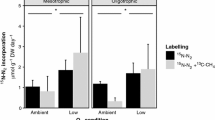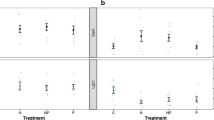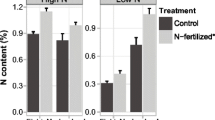Abstract
Background and aims
Nitrogen (N2) fixation by moss-associated bacteria is an important N source in boreal peatlands and forests. Here we studied whether moss species, water table fluctuations, methane (CH4) availability and diazotroph community structure would affect the rate of Sphagnum-associated N2 fixation.
Methods
Diazotrophy and methanotrophy were studied in parallel in a double labeling (15 N2 and 13CH4) experiment in forest and fen habitats. The role of N2-fixing methanotrophs was further characterized by the phylogenetic analysis of nifH genes encoding for dinitrogenase reductase.
Results
N2 fixation rates were dependent on the moss species in a habitat level, but independent of the diazotroph community structure. Only 6 % of the nifH sequences were taxonomically assigned to cyanobacteria, while the majority (82 %) of genes were assigned to Alphaproteobacteria clustering with the nifH sequences of the order Rhizobiales, but without close matches to sequences of cultivated species. In the originally submerged fen mosses, water increased both N2 fixation and CH4 oxidation rates. However, such effect was not seen in forest mosses grown above the water table level. CH4 addition did not enhance N2 fixation.
Conclusions
N2 fixation associated to Sphagnum mosses was controlled by the moss species and the water environment. Although most of the observed nifH sequences were related to the order Rhizobiales, methanotrophs were not responsible for the N2 fixation.




Similar content being viewed by others
References
Altschul SF, Madden TL, Schäffer AA, Zhang J, Zhang Z, Miller W, Lipman D (1997) Gapped BLAST and PSI-BLAST: a new generation of protein database search programs. Nucleic Acids Res 25:3389–3402
Anderson MJ (2001) A new method for non-parametric multivariate analysis of variance. Austral Ecol 26:32–46
Basilier K (1979) Moss-associated nitrogen fixation in some mire and coniferous forest environments around Uppsala, Sweden. Lindbergia 5:84–88
Basiliko N, Knowles R, Moore TR (2004) Roles of moss species and habitat in methane consumption potential in a northern peatland. Wetlands 24:78–185
Berg A, Danielsson Å, Svensson BH (2013) Transfer of fixed-N from N2-fixing cyanobacteria associated with the moss Sphagnum riparium results in enchanced growth of the moss. Plant Soil 326:271–278
Bragina A, Berg C, Cardinale M, Shcherbakov A, Chebotar V, Berg G (2012a) Sphagnum mosses harbour highly specific bacterial diversity during their whole lifecycle. ISME J 6:802–813
Bragina A, Maier S, Berg C, Müller H, Chobit V, Hadacek F, Berg G (2012b) Similar diversity of Alphaproteobacteria and nitrogenase gene amplicons on two related Sphagnum mosses. Front Microbiol 2:275. doi:10.3389/fmicb.2011.00275
Bragina A, Berg C, Müller H, Moser D, Berg G (2013) Insights into functional bacterial diversity and its effects on Alpine bog ecosystem functioning. Sci Rep 3:1955. doi:10.1038/srep01955
DeBont JAM, Mulder EG (1967) Invalidity of the acetylene reduction assay in alkane–utilizing, nitrogen–fixing bacteria. Appl Environ Microbiol 31:640–647
Dedysh SN (2011) Cultivating uncultured bacteria from northern wetlands: knowledge gained and remaining gaps. Front Microbiol 2:184. doi:10.3389/fmicb.2011.00184
DeLuca TH, Zackrisson O, Gentili F, Sellstedt A, Nilsson M-C (2007) Ecosystem controls on nitrogen fixation in boreal feather moss communities. Oecologia 152:121–130
DeLuca TH, Zackrisson O, Nilsson M-C, Sellstedt A (2002) Quantifying nitrogen–fixation in feather moss carpets of boreal forests. Nature 419:917–920
Demba Diallo M, Willems A, Vloemans N, Cousin S, Vandekerckhove TT, de Lajudie P, Neyra M, Vyverman W, Gillis M, van der Gucht K (2004) Polymerase chain reaction denaturing gradient gel electrophoresis analysis of the N2–fixing bacterial diversity in soil under Acacia tortilis ssp. raddiana and Balanites aegyptiaca in the dryland part of Senegal. Environ Microbiol 6:400–415
Eurola S, Bendiksen K, Rönkä A (1992) Suokasviopas. Oulanka Biological Station, University of Oulu, Oulanka Reports. Oulu
Fay P (1992) Oxygen relations in nitrogen fixation in cyanobacteria. Microbiol Rev 56:340–373
Fry B (2006) Technical supplement 6B: Noisy data and data analysis with enriched samples. Stable isotope ecology, New York, Springer
Gaby JC, Buckley DH (2012) A comprehensive evaluation of PCR primers to amplify the nifH gene of nitrogenase. PLoS ONE 7:doi:10.1371/journal.pone.0042149
Gavazov KS, Soudzilovskaia NA, van Logtestijn RSP, Braster M, Cornelissen JHC (2010) Isotopic analysis of cyanobacterial nitrogen fixation associated with subarctic lichen and bryophyte species. Plant Soil 333:507–517
Granhall U, Selander H (1973) Nitrogen fixation in a subarctic mire. Oikos 24:8–15
Ininbergs K, Bay G, Rasmussen U, Wardle DA, Nilsson M-C (2011) Composition and diversity of nifH genes of nitrogen-fixing cyanobacteria associated with boreal forest feather mosses. New Phytol 192:507–517
Kaiser C, Meyer H, Biasi C, Rusalimova O, Barsukov P, Richter A (2005) Storage and mineralization of carbon and nitrogen in soils of a frost-boil tundra ecosystem in Siberia. Appl Soil Ecol 29:173–183
Kulichevskaya IS, Danilova OV, Tereshina VM, Kevbrin VV, Dedysh SN (2014) Descriptions of Roseiarcus fermentans gen. nov., sp. nov., a bacteriochlorophyll a-containing fermentative bacterium related phylogenetically to alphaproteobacterial methanotrophs, and of the family Roseiarcaceae fam. nov. Int J Syst Evol Microbiol 64:2558–2565
Laine J, Harju P, Timonen T, Laine A, Tuittila E-S, Minkkinen K, Vasander H (2009) The intricate beauty of Sphagnum mosses – a Finnish guide to identification. University of Helsinki, Department of Forest Ecology Publications 39:1–190
Larmola T, Leppänen SM, Tuittila ES, Aarva M, Merilä P, Fritze H, Tiirola M (2014) Methanotrophy induces nitrogen fixation during peatland development. PNAS 111:734–739
Larmola T, Tuittila E-S, Tiirola M, Nykänen H, Martikainen PJ, Yrjälä K, Tuomivirta T, Fritze H (2010) The role of Sphagnum mosses in the methane cycling of a boreal mire. Ecology 91:2356–2365
Leppänen SM, Salemaa M, Smolander A, Mäkipää R, Tiirola M (2013) Nitrogen fixation and methanotrophy in forest mosses along a N deposition gradient. Environ Exp Bot 90:62–69
Lett S, Michelsen A (2014) Seasonal variation in nitrogen fixation and effects of climate change in a subarctic heath. Plant Soil 379:193–201
Markham JH (2009) Variation in moss–associated nitrogen fixation in boreal forest stands. Oecologia 161:353–359
McArdle BH, Anderson MJ (2001) Fitting multivariate models to community data: a comment on distance –based redundancy analysis. Ecology 82:290–297
McCune B, Mefford MJ (2006) PC–ORD for Windows: multivariate analysis of ecological data. Edition 5.31. Oregon: MjM Software, Gleneden Beach
Nzoué A, Miché L, Klonowska A, Laguerre G, de Lajudie P, Moulin L (2009) Multilocus sequence analysis of bradyrhizobia isolated from Aeschynomene species in Senegal. Syst Appl Microbiol 32:400–412
Papaefthimiou D, Van Hove C, Lejeune A, Rasmussen U, Wilmotte A (2008) Diversity and host specificity of Azolla cyanobionts. J Phycol 44:60–70
Poly F, Ranjard L, Nazaret S, Goubière F, Monrozier LJ (2001) Comparison of nifH gene pools in soils and soil microenvironments with contrasting properties. Appl Environ Microbiol 67:2255–2262
Putkinen A, Larmola T, Tuomivirta T, Siljanen HMP, Bodrossy L, Tuittila ES, Fritze H (2012) Water dispersal of methanotrophic bacteria maintains functional methane oxidation in Sphagnum mosses. Front Microbiol 3:15. doi:10.3389/fmicb.2012.00015
Putkinen A, Larmola T, Tuomivirta T, Siljanen HMP, Bodrossy L, Tuittila ES, Fritze H (2014) Peatland succession induces a shift in the community composition of Sphagnum-associated active methanotrophs. FEMS Microbiol Ecol 88:596–611
Quinn GP, Keough MJ (2002) Experimental design and data analysis for biologists. Cambridge University Press, Cambridge
Raghoebarsing AA, Smolders AJP, Schmid MC, Rijpstra WIC, Wolters-Arts M, Jan Derksen J, Jetten MSM, Schouten S, Damsté JPS, Lamers LPM, Roelofs JGM, Op den Camp HJM, Strous M (2005) Methanotrophic symbionts provide carbon for photosynthesis in peat bogs. Nature 436:1153–1156
Reed SC, Townsend AR, Cleveland CC, Nemergut DR (2010) Microbial community shifts influence patterns in tropical forest nitrogen fixation. Oecologia 164:521–531
Rissanen AJ, Tiirola M, Hietanen S, Ojala A (2013) Interlake variation and environmental controls of denitrification across different geographical scales. Aquat Microb Ecol 69:1–16
Schloss PD, Westcott SL, Ryabin T, Hall JR, Hartmann M, Hollister EB, Lesniewski RA, Oakley BB, Parks DH, Robinson CJ, Sahl JW, Stres B, Thallinger GG, van Horn DJ, Weber CF (2009) Introducing mothur: Open–source, platform–independent, community–supported software for describing and comparing microbial communities. Appl Environ Microbiol 75:7537–7541
Simonet P, Grosjean MC, Misra AK, Nazaret S, Cournoyer B, Normand P (1991) Frankia genus-specific characterization by polymerase chain reaction. Appl Environ Microbiol 57:3278–3286
Sorensen PL, Michelsen A (2011) Long-term warming and litter addition affects nitrogen fixation in a subarctic heath. Glob Change Biol 17:528–537
Tamas I, Smirnova AV, He Z, Dunfield PF (2014) The (d)evolution of methanotrophy in the Beijerinckiaceae–a comparative genomics analysis. ISME J 8:369–382
Tamura K, Dudley J, Nei M, Kumar S (2007) MEGA4: Molecular evolutionary genetics analysis (MEGA) software version 4.0. Mol Biol Evol 24:1596–1599
Vile MA, Wieder RK, Živković T, Scott KD, Vitt DH, Hartsock JA, Iosue CL, Quinn JC, Petix M, Fillingim HM, Popma JMA, Dynarski KA, Jackman TR, Albright CM, Wykoff DD (2014) N2-fixation by methanotrophs sustains carbon and nitrogen accumulation in pristine peatlands. Biogeochemistry 121:317–328
Wang Q, Quensen III JF, Fish JA, Lee TK, Sun JM, Tiedje JM, Cole JR (2013) Ecological patterns of nifH genes in four terrestrial climatic zones explored with targeted metagenomics using FrameBot, a new informatics tool. mBio 4:e00592-13
Zackrisson O, DeLuca TH, Gentili F, Sellstedt A, Jäderlund A (2009) Nitrogen fixation in mixed Hylocomium splendens moss communities. Oecologia 160:309–319
Zadorina EV, Slobodova NV, Boulygina ES, Kolganova TV, Kravchenko IK, Kuznetsov BB (2009) Analysis of the diversity of diazotrophic bacteria in peat soil by cloning of the nifH gene. Microbiology 78:258–267
Zehr JP, Jenkins BD, Short SM, Steward GF (2003) Nitrogenase gene diversity and microbial community structure: a cross-system comparison. Env Microbiol 5:539–554
Zehr JP, McReynolds LA (1989) Use of degenerate oligonucleotides for amplification of the nifH gene from the marine cyanobacterium Trichodesmium thiebautii. Appl Environ Microbiol 55:2522–2526
Acknowledgments
We would like to thank Katriina Peltonen for providing a list of suitable Sphagnum habitats, and Nina Honkanen for helping in the sample processing. This work was funded by the Academy of Finland grant to MT (Projects 120089 and 123726) and Biological Interactions Graduate School funding to SML.
Author information
Authors and Affiliations
Corresponding author
Additional information
Responsible Editor: Paul Bodelier.
Electronic supplementary material
Below is the link to the electronic supplementary material.
Online Resource 1
(PDF 915 kb)
Online Resource 2
(PDF 90 kb)
Online Resource 3
(PDF 72 kb)
Online Resource 4
(PDF 112 kb)
Rights and permissions
About this article
Cite this article
Leppänen, S.M., Rissanen, A.J. & Tiirola, M. Nitrogen fixation in Sphagnum mosses is affected by moss species and water table level. Plant Soil 389, 185–196 (2015). https://doi.org/10.1007/s11104-014-2356-6
Received:
Accepted:
Published:
Issue Date:
DOI: https://doi.org/10.1007/s11104-014-2356-6




